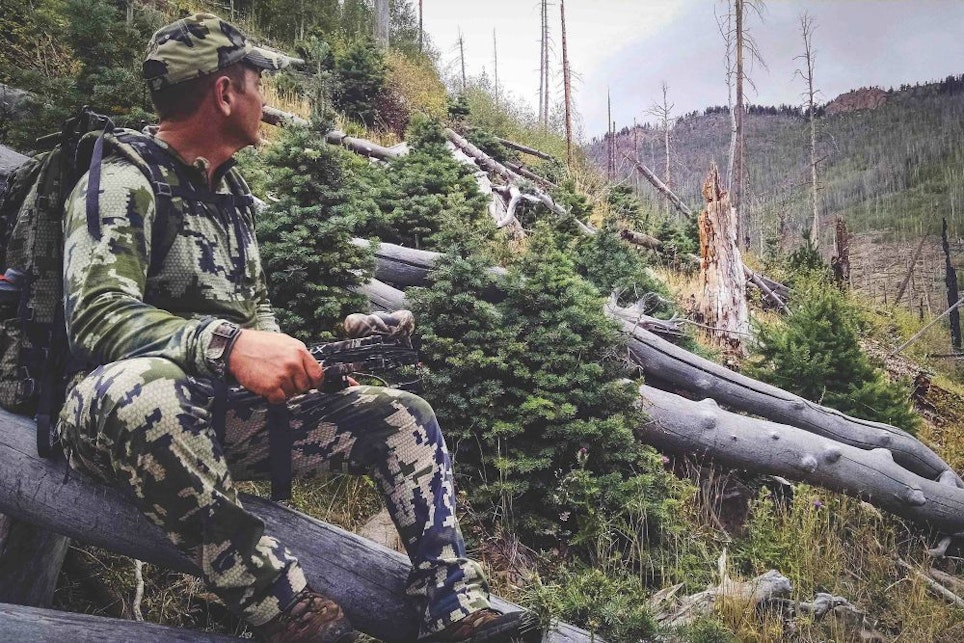
After 2 days waiting out 90-mph winds and whiteout conditions, Brandon Neitzel sets out for caribou in Greenland. Photo courtesy of Sitka Gear Facebook.
Bowhunts come in all shapes and sizes, taking place across the globe in a wide variety of environments, ranging from arid deserts to snow-covered mountains. Regardless of a bowhunt’s shape or size, let’s face it, ALL bowhunts are challenging. That being said, is there a direct correlation between challenge and the classification of extreme? To define an answer, let’s take a deeper look at the question.
Tools or Lack Thereof?
As bowhunters, our tools of choice are the bow and arrow. For some, it’s a crossbow and for others, it’s a compound. And for a small fraction, the tool is a traditional bow. Does simply limiting the tool equate to extreme?
Species of Game?
I believe it’s safe to say that the majority of bowhunters pursue whitetails more than any other big game species. Of course, whether or not that is true likely depends on where one lives. Still, the whitetail is by far the most pursued by hunters across the United States. So then, does simply going on a bowhunt for bighorn sheep equal extreme?
Far From Home?
Imagine traveling by air for 20-plus hours, and after landing, traveling another 4 hours by vehicle. The destination: lush, steep and amazingly beautiful slopes of the Southern Alps in the South Pacific. The game: bucket-list New Zealand red stag. Independent of how the rest of the bowhunt unfolds, this once-of-a-lifetime bowhunt is definitely exotic, but is it extreme?
Inclement Weather?
Any hunt can become more challenging under less-than-ideal weather conditions. Pursuing game in freezing or scorching temperatures definitely adds to the complexity of any given bowhunt. Not only does it directly affect the hunter, but the hunted could be less active under these conditions as well. Does adverse weather create a condition of extreme?
Physically and Mentally Challenging?
As the ruggedness of the hunt increases, so too does the need to be in topnotch shape, not to mention mentally prepared. Hiking miles into the wilderness, eating minimally and exerting oneself over and over in the pursuit of game can raise the stakes. Yet, is this extreme?
Possibility of Death?
Every bowhunt has the potential to take a turn for the worse. There are numerous unforeseen events that can lead to a terrible accident, whether it’s the onset of hyperthermia or a cut incurred from the blade of a broadhead. In fact, these types of accidents could prove fatal. Additionally, there are several large game animals — such as the grizzly bear — that can go from hunted to hunter in a split-second. Does a slightly higher probability of death change the level to extreme?
One Bowhunter's Answer
So, what is extreme? To begin, the answer is definitely an individual one. Furthermore, it is highly dependent on one’s baseline description of a normal hunt. While any or all of the above scenarios could be deemed extreme, in all likelihood, an extreme hunt is one that comprises many or all of the characteristics described above.
For me, an extreme hunt is one that — for whatever reason(s) — takes a higher degree of fortitude to skillfully overcome an array of challenges in order to be successful. One may have looked for and found the challenges selectively, or the stakes may have been raised arbitrarily. Whatever the case, this is what makes a bowhunt extreme for me.
I’d like to hear your opinion on this subject. And as always, if there is a topic you would like to see highlighted or expanded upon in the pages of Bowhunting World, or you would just like to send me a note, please do not hesitate to send an email with your thoughts: darren.choate@grandviewoutdoors.com. Best to you!






